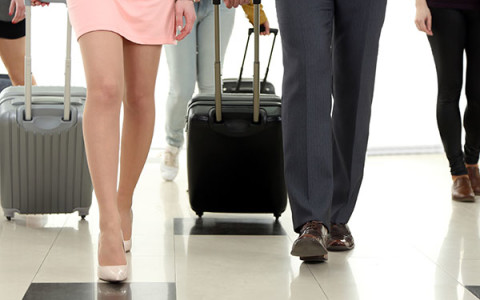
Effects of a Heavy Suitcase
Lifting, lowering, pushing, pulling, carrying, holding, and dragging heavy loads involve static and dynamic efforts, which cause strain on muscles and joints, and wear and tear on the back.
Tips for Selecting the Right Suitcase
- Size: Buy different size suitcases for different occasions. The size should reflect the length of your trip.
- Type: If traveling by air, select wheeled luggage. If traveling by car, select duffels or garment bags.
- Material: Avoid selecting suitcases made of heavy material such as leather. This only adds extra weight. Instead, select a suitcase made of lighter, durable material such as vinyl and canvas.
- Handles: Select a suitcase with extending handles with a swivel feature, with padded handles to protect the joints in your hands and fingers from excess pressure, and with handles at both ends, which will make it easier to pull the bag out of a tightly packed overhead compartment.
- Wheels: Select a suitcase with large wheels. The suitcase should have 4 wheels, allowing for smooth rolling over various surfaces and better maneuverability through small spaces and aisles, or 2 wheels with a 360° turning radius.
Tips for Packing a Suitcase Correctly
- General: Make a list of what you will need on your trip to ensure that you only pack essential items. Instead of packing one heavy suitcase, consider distributing weight, and take two smaller suitcases to avoid back strain when lifting your suitcase into the overhead bin. If you are going on a long trip, consider shipping items ahead of time, and taking one small light suitcase on your flight.
- Clothes: Decide what you will wear in advance, and pack only those items. Consider packing less and making use of laundry facilities during your stay. Check the weather before your trip to avoid packing “just-in-case” clothes. Wear your heaviest clothing items on the plane.
- Footwear: Pack no more than 3 pairs of footwear. Pack shoes that can be worn with multiple outfits.
- Toiletries: Most hotels provide complimentary toiletries. Downsize toiletries and look for travel-size versions of your favorite products or transfer into small containers.
Tips for Carrying Your Suitcase Correctly
- Opt for carrying two light suitcases, one in each hand, rather than carrying one heavy suitcase in one hand or on your shoulder.
- Avoid carrying heavy suitcases for prolong periods. Carry heavy items close to your body. Switch positions frequently to avoid fatigue from muscle overuse.
- When using a 2-wheeled (360° turning radius) suitcase with adjustable handles, push the suitcase in front of you or to your right or left side instead of pulling it behind you.
Tips for Loading a Suitcase in an Airplane Correctly
- Do not rush—move slowly! Lift your luggage in stages. When loading your luggage into an overhead bin, first lift it to the top of the seat, rest, and then lift it into the overhead bin.
These tips were provided by Brittney Nichols, OTS (brittneynichols@gmail.com); Priscilla Nova, OTS (priscillanova@gmail.com); and Karen Jacobs, EdD, OTR/L, CPE, FAOTA (kjacobs@bu.edu) of Boston University.
